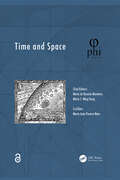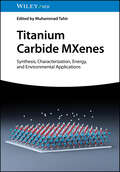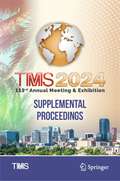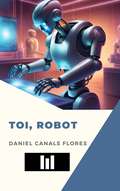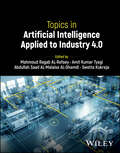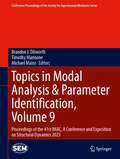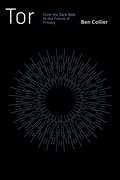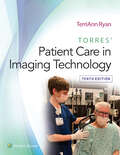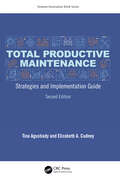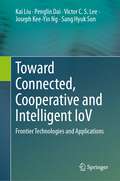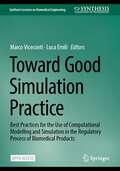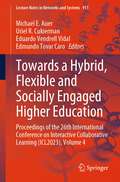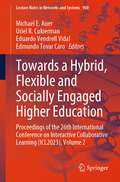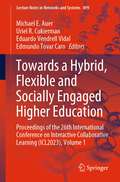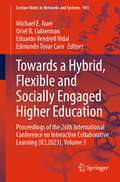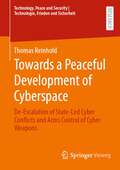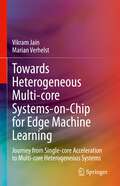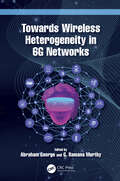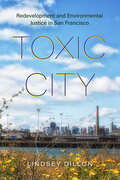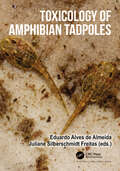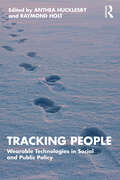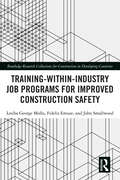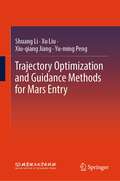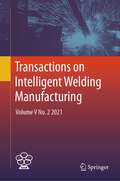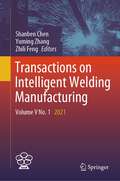- Table View
- List View
Time and Space (PHI)
by Maria do Rosário Monteiro Mário S. Ming KongThe texts presented in Proportion Harmonies and Identities (PHI) Time and Space were compiled to establish a multidisciplinary platform for presenting, interacting, and disseminating research. It also aims to foster awareness and discussion on Time and Space, focusing on different visions relevant to Architecture, Arts and Humanities, Design and Social Sciences, and its importance and benefits for the sense of identity, both individual and communal. The idea of Time and Space has been a powerful motor for development since the Western Early Modern Age. Its theoretical and practical foundations have become the working tools of scientists, philosophers, and artists, who seek strategies and policies to accelerate the development process in different contexts.
Titanium Carbide MXenes: Synthesis, Characterization, Energy and Environmental Applications
by Muhammad TahirTitanium Carbide MXenes Discover the future of solar energy with this introduction to an essential new family of materials MXenes are a recently-discovered family of two-dimensional organic compounds formed from transition metal carbides. Their unique properties, such as high stability and electron conductivity, have made them a sought-after commodity with many industrial applications in cutting-edge industries. In particular, titanium carbide MXenes look poised to have significant applications in the solar energy industry, with potentially revolutionary consequences for the sustainable energy future. Titanium Carbide MXenes offers a thorough and accessible introduction to this family of compounds and their possible applications. It begins by surveying the fundamentals of the MXene groups, before characterizing titanium carbide MXenes and their processes of synthesis. It then moves on to discuss applications, current and future. The result is a must-read for researchers and professionals looking to synthesize and construct these materials and apply them in sustainable industry. Titanium Carbide MXenes readers will also find: Detailed treatment of MXenes including nitrides composites, perovskites composites, and more Discusses applications in photocatalytic CO2 reduction, hydrogen production, water splitting, and more Roughly 100 figures illustrating key concepts Titanium Carbide MXenes is a must-have for materials scientists, catalytic chemists, and scientists in industry.
TMS 2024 153rd Annual Meeting & Exhibition Supplemental Proceedings (The Minerals, Metals & Materials Series)
by The Minerals, Metals & Materials SocietyThis collection presents papers from the 153rd Annual Meeting & Exhibition of The Minerals, Metals & Materials Society.
Toi, robot
by Daniel Canals FloresToi, robot, Il est un sérieux avertissement pour l’humanité. En écrivant cette histoire, un frisson m'a traversé l'âme: l'acronyme I.A. (Intelligence Artificielle) correspondent à celles du génie robotique incontesté Isaac Asimov. Le professeur en était-il conscient? Ce livre est un hommage à son œuvre et à sa vision futuriste inquiétante. La quatrième révolution industrielle et l'égoïsme de quelques-uns engendreront le monstre qui finira par dominer l'Univers et détruire l'espèce humaine...
Topics in Artificial Intelligence Applied to Industry 4.0
by Mahmoud Ragab AL-Refaey Amit Kumar Tyagi Abdullah Saad AL-Malaise Swetta KukrejaTopics in Artificial Intelligence Applied to Industry 4.0 Forward thinking resource discussing emerging AI and IoT technologies and how they are applied to Industry 4.0 Topics in Artificial Intelligence Applied to Industry 4.0 discusses the design principles, technologies, and applications of emerging AI and IoT solutions on Industry 4.0, explaining how to make improvements in infrastructure through emerging technologies. Providing a clear connection with different technologies such as IoT, Big Data, AR and VR, and Blockchain, this book presents security, privacy, trust, and other issues whilst delving into real-world problems and case studies. The text takes a highly practical approach, with a clear insight on how readers can increase productivity by drastically shortening the time period between the development of a new product and its delivery to customers in the market by 50%. This book also discusses how to save energy across systems to ensure competitiveness in a global market, and become more responsive in how they produce products and services for their consumers, such as by investing in flexible production lines. Written by highly qualified authors, Topics in Artificial Intelligence Applied to Industry 4.0 explores sample topics such as: Quantum machine learning, neural network implementation, and cloud and data analytics for effective analysis of industrial data Computer vision, emerging networking technologies, industrial data spaces, and an industry vision for 2030 in both developing and developed nations Novel or improved nature-inspired optimization algorithms in enhancing Industry 5.0 and the connectivity of any components for smart environment Future professions in agriculture, medicine, education, fitness, R&D, and transport and communication as a result of new technologies Aimed at researchers and students in the interdisciplinary fields of Smart Manufacturing and Smart Applications, Topics in Artificial Intelligence Applied to Industry 4.0 provides the perfect overview of technology from the perspective of modern society and operational environment.
Topics in Modal Analysis & Parameter Identification, Volume 9: Proceedings of the 41st IMAC, A Conference and Exposition on Structural Dynamics 2023 (Conference Proceedings of the Society for Experimental Mechanics Series)
by Brandon J. Dilworth Timothy Marinone Michael MainsTopics in Modal Analysis, Testing & Parameter Identification, Volume 9: Proceedings of the 41st IMAC, A Conference and Exposition on Structural Dynamics, 2023, the ninth volume of ten from the Conference brings together contributions to this important area of research and engineering. The collection presents early findings and case studies on fundamental and applied aspects of Modal Analysis, Modal Testing and Modal Parameter Identification including papers on:Analytical MethodsModal ApplicationsBasics of Modal AnalysisExperimental TechniquesOperational Modal AnalysisModal Parameter IdentificationNovel TechniquesRotating MachineryAdditive Manufacturing ApplicationsBiomedical Applications
Tor: From the Dark Web to the Future of Privacy
by Ben CollierA biography of Tor—a cultural and technological history of power, privacy, and global politics at the internet's core.Tor, one of the most important and misunderstood technologies of the digital age, is best known as the infrastructure underpinning the so-called Dark Web. But the real &“dark web,&” when it comes to Tor, is the hidden history brought to light in this book: where this complex and contested infrastructure came from, why it exists, and how it connects with global power in intricate and intimate ways. In Tor: From the Dark Web to the Future of Privacy, Ben Collier has written, in essence, a biography of Tor—a cultural and technological history of power, privacy, politics, and empire in the deepest reaches of the internet.The story of Tor begins in the 1990s with its creation by the US Navy&’s Naval Research Lab, from a convergence of different cultural worlds. Drawing on in-depth interviews with designers, developers, activists, and users, along with twenty years of mailing lists, design documents, reporting, and legal papers, Collier traces Tor&’s evolution from those early days to its current operation on the frontlines of global digital power—including the strange collaboration between US military scientists and a group of freewheeling hackers called the Cypherpunks. As Collier charts the rise and fall of three different cultures in Tor&’s diverse community—the engineers, the maintainers, and the activists, each with a distinct understanding of and vision for Tor—he reckons with Tor&’s complicated, changing relationship with contemporary US empire. Ultimately, the book reveals how different groups of users have repurposed Tor and built new technologies and worlds of their own around it, with profound implications for the future of the Internet.
Torres' Patient Care in Imaging Technology
by TerriAnn RyanNow fully aligned with the latest ARRT and ASRT standards,Torres’ Patient Care in Imaging Technology, 10th Edition, by TerriAnn Ryan, helps students develop the knowledge and skills they need to become safe, perceptive, and efficient radiologic technologists. This student-focused text offers a strong illustration program and a logical organization that emphasizes the connections between classroom learning and clinical practice. Designed to keep readers informed and up to date, it covers current trends and advances in the field and offers an unparalleled array of online teaching and learning resources.
Total Productive Maintenance: Strategies and Implementation Guide (Systems Innovation Book Series)
by Tina Agustiady Elizabeth A. CudneyThis new edition emphasizes new techniques and strategies to Total Productive Maintenance (TPM) through the use of innovation and management after the pandemic to show effective communication and implementation of TPM techniques.Total Productive Maintenance: Strategies and Implementation Guide, Second Edition, presents step-by-step approaches to TPM integration with a clear direction from project infancy to completion. It discusses innovation and management through the use of TPM and offers empowerment and encouragement to associates so they feel more comfortable using TPM in everyday settings. The book is completely updated specifically with new case studies of implementing TPM after the pandemic, cultural change, and what that entails.The book is written for manufacturing engineers, reliability engineers, industrial engineers, operations managers, factory managers, project managers, supply chain managers, logistics, and can also be used as additional reading in the classroom.
Toward Connected, Cooperative and Intelligent IoV: Frontier Technologies and Applications
by Kai Liu Penglin Dai Victor C.S. Lee Joseph Kee-Yin Ng Sang Hyuk SonThis book offers a comprehensive introduction to technological advances in Internet of Vehicles (IoV), including vehicular communications, vehicular system architectures, data dissemination algorithms, resource allocation schemes, and AI-enabled applications. It focuses on the state-of-the-art IoV with regard to three major directions, namely networking, cooperation, and intelligence, including advanced wireless communication technologies, algorithm theory, optimization mechanisms, and AI technologies. In addition, the book includes a number of case studies with system prototype implementation and hands-on experiments in IoV, making it suitable both as a technical reference work for professionals and as a textbook for graduate students.
Toward Good Simulation Practice: Best Practices for the Use of Computational Modelling and Simulation in the Regulatory Process of Biomedical Products (Synthesis Lectures on Biomedical Engineering)
by Marco Viceconti Luca EmiliThis open access book, the Community of Practice led by the VPH Institute, the Avicenna Alliance, and the In Silico World consortium has brought together 138 experts in In Silico Trials working in academia, the medical industry, regulatory bodies, hospitals, and consulting firms. Through a consensus process, these experts produced the first attempt to define some Good Simulation Practices on how to develop, evaluate, and use In Silico Trials. Good Simulation Practice constitutes an indispensable guide for anyone who is planning to engage at any title with In Silico Trials.
Towards a Hybrid, Flexible and Socially Engaged Higher Education: Proceedings of the 26th International Conference on Interactive Collaborative Learning (ICL2023), Volume 4 (Lecture Notes in Networks and Systems #911)
by Michael E. Auer Uriel R. Cukierman Eduardo Vendrell Vidal Edmundo Tovar CaroWe are currently witnessing a significant transformation in the development of education on all levels and especially in post-secondary education. To face these challenges, higher education must find innovative and effective ways to respond in a proper way. The pandemic period left us with profound changes in the way we teach and learn, including the massive use of new means of communication, such as videoconferencing and other technological tools. Moreover, the current explosion of artificial intelligence tools, mainly used by students, is challenging teaching practices maintained for centuries. Scientifically based statements as well as excellent best practice examples are absolutely necessary.The 26th International Conference on Interactive Collaborative Learning (ICL2023), which will take place in Madrid, Spain, between 26th and 30th September 2023, will be the perfect place where to present and discuss current trends in Higher Education.Since its beginning in 1998 this conference is devoted to new approaches in learning with a focus on collaborative learning in Higher Education. Nowadays the ICL conferences are a forum of the exchange of relevant trends and research results as well as the presentation of practical experiences in Learning and Engineering Pedagogy. In this way we try to bridge the gap between ‘pure’ scientific research and the everyday work of educators.
Towards a Hybrid, Flexible and Socially Engaged Higher Education: Proceedings of the 26th International Conference on Interactive Collaborative Learning (ICL2023), Volume 2 (Lecture Notes in Networks and Systems #900)
by Michael E. Auer Uriel R. Cukierman Eduardo Vendrell Vidal Edmundo Tovar CaroThis book contains papers in the fields of educational virtual environments, future of education, project-based learning (PBL), and digital education strategy and engineering pedagogy. The authors currently witnessing a significant transformation in the development of education on all levels and especially in post-secondary education. To face these challenges, higher education must find innovative and effective ways to respond in a proper way. The pandemic period left us with profound changes in the way we teach and learn, including the massive use of new means of communication, such as videoconferencing and other technological tools. Moreover, the current explosion of artificial intelligence tools, mainly used by students, is challenging teaching practices maintained for centuries. Scientifically based statements as well as excellent best practice examples are absolutely necessary. The 26th International Conference on Interactive Collaborative Learning (ICL2023), which took place in Madrid, Spain, between September 26 and 30, 2023, was the perfect place where current trends in higher education were presented and discussed. Since its beginning in 1998, this conference has been devoted to new approaches in learning with a focus on collaborative learning in higher education. Nowadays, the ICL conferences are a forum of the exchange of relevant trends and research results as well as the presentation of practical experiences in learning and engineering pedagogy. In this way, the authors try to bridge the gap between ‘pure’ scientific research and the everyday work of educators. Interested readership includes policy makers, academics, educators, researchers in pedagogy and learning theory, schoolteachers, learning industry, further and continuing education lecturers, etc.
Towards a Hybrid, Flexible and Socially Engaged Higher Education: Proceedings of the 26th International Conference on Interactive Collaborative Learning (ICL2023), Volume 1 (Lecture Notes in Networks and Systems #899)
by Michael E. Auer Uriel R. Cukierman Eduardo Vendrell Vidal Edmundo Tovar CaroThis book contains papers in the fields of collaborative learning, digital transition in education, and AI and learning analytics in engineering education. The authors are currently witnessing a significant transformation in the development of education on all levels and especially in post-secondary education. To face these challenges, higher education must find innovative and effective ways to respond in a proper way. The pandemic period left us with profound changes in the way we teach and learn, including the massive use of new means of communication, such as videoconferencing and other technological tools. Moreover, the current explosion of artificial intelligence tools, mainly used by students, is challenging teaching practices maintained for centuries. Scientifically based statements as well as excellent best practice examples are absolutely necessary. The 26th International Conference on Interactive Collaborative Learning (ICL2023), which took place in Madrid, Spain, between September 26 and 30, 2023, was the perfect place where current trends in higher education were presented and discussed. Since its beginning in 1998, this conference has been devoted to new approaches in learning with a focus on collaborative learning in higher education. Nowadays, the ICL conferences are a forum of the exchange of relevant trends and research results as well as the presentation of practical experiences in learning and engineering pedagogy. In this way, the authors try to bridge the gap between ‘pure’ scientific research and the everyday work of educators. Interested readership includes policy makers, academics, educators, researchers in pedagogy and learning theory, schoolteachers, learning industry, further and continuing education lecturers, etc.
Towards a Hybrid, Flexible and Socially Engaged Higher Education: Proceedings of the 26th International Conference on Interactive Collaborative Learning (ICL2023), Volume 3 (Lecture Notes in Networks and Systems #901)
by Michael E. Auer Uriel R. Cukierman Eduardo Vendrell Vidal Edmundo Tovar CaroThis book contains papers in the fields of engineering pedagogy education, research in engineering pedagogy, and games in engineering education. The authors are currently witnessing a significant transformation in the development of education on all levels and especially in post-secondary education. To face these challenges, higher education must find innovative and effective ways to respond in a proper way. The pandemic period left us with profound changes in the way we teach and learn, including the massive use of new means of communication, such as videoconferencing and other technological tools. Moreover, the current explosion of artificial intelligence tools, mainly used by students, is challenging teaching practices maintained for centuries. Scientifically based statements as well as excellent best practice examples are absolutely necessary. The 26th International Conference on Interactive Collaborative Learning (ICL2023), which took place in Madrid, Spain, between September 26 and 30, 2023, was the perfect place where current trends in higher education were presented and discussed. Since its beginning in 1998, this conference has been devoted to new approaches in learning with a focus on collaborative learning in higher education. Nowadays, the ICL conferences are a forum of the exchange of relevant trends and research results as well as the presentation of practical experiences in learning and engineering pedagogy. In this way, the authors try to bridge the gap between ‘pure’ scientific research and the everyday work of educators. Interested readership includes policy makers, academics, educators, researchers in pedagogy and learning theory, schoolteachers, learning industry, further and continuing education lecturers, etc.
Towards a Peaceful Development of Cyberspace: De-Escalation of State-Led Cyber Conflicts and Arms Control of Cyber Weapons (Technology, Peace and Security I Technologie, Frieden und Sicherheit)
by Thomas ReinholdThe cyberspace and its global infrastructures are essential for our civilizations, the economy and administration. However, cyberspace is also increasingly developing into an intelligence and military operational area, visible in the creation of military cyber departments and the integration of cyberspace into states' security and defense strategies. Unfortunately, many of the established toolset of transparency, de-escalation and arms control measures do not work for cyberspace due to its specific technical characteristics. But how de-escalation of state-led conflicts in cyberspace can be achieved and how arms control of cyber weapons can be developed? Based on a technical perspective with regard to the underlying political challenges, the book follows an approach of adopting already existing technical measures from other fields of the computer science. It presents a classification system for cyberweapons, an approach for the mutual reduction of vulnerability stockpiles and provides an approach to prove the non-involvement in a cyber conflict. Beyond this, it aims to provide some impulses regarding the responsibility and creative options of the computer science with a view to the peaceful development and use of cyberspace.
Towards Heterogeneous Multi-core Systems-on-Chip for Edge Machine Learning: Journey from Single-core Acceleration to Multi-core Heterogeneous Systems
by Vikram Jain Marian VerhelstThis book explores and motivates the need for building homogeneous and heterogeneous multi-core systems for machine learning to enable flexibility and energy-efficiency. Coverage focuses on a key aspect of the challenges of (extreme-)edge-computing, i.e., design of energy-efficient and flexible hardware architectures, and hardware-software co-optimization strategies to enable early design space exploration of hardware architectures. The authors investigate possible design solutions for building single-core specialized hardware accelerators for machine learning and motivates the need for building homogeneous and heterogeneous multi-core systems to enable flexibility and energy-efficiency. The advantages of scaling to heterogeneous multi-core systems are shown through the implementation of multiple test chips and architectural optimizations.
Towards Wireless Heterogeneity in 6G Networks
by Abraham George G. Ramana MurthyThe connected world paradigm effectuated through the proliferation of mobile devices, Internet of Things (IoT), and the metaverse will offer novel services in the coming years that need anytime, anywhere, high-speed access. The success of this paradigm will highly depend on the ability of the devices to always obtain the optimal network connectivity for an application and on the seamless mobility of the devices. This book will discuss 6G concepts and architectures to support next-generation applications such as IoT, multiband devices, and high-speed mobile applications. IoT applications put forth significant challenges on the network in terms of spectrum utilization, latency, energy efficiency, large number of users, and supporting different application characteristics in terms of reliability, data rate, and latency.While the 5G network developmentwas motivated by the need for larger bandwidth and higher quality of service (QoS), 6G considerations are supporting many users with a wide application requirement, lowering network operating cost, and enhanced network flexibility. Network generations beyond 5G are expected to accommodate massive number of devices with the proliferation of connected devices concept in connected cars, industrial automation, medical devices, and consumer devices.This book will address the fundamental design consideration for 6G networks and beyond. There are many technical challenges that need to be explored in the next generation of networks, such as increased spectrum utilization, lower latency, higher data rates, accommodating more users, heterogeneous wireless connectivity, distributed algorithms, and device-centric connectivity due to diversified mobile environments and IoT application characteristics. Since 6G is a multidisciplinary topic, this book will primarily focus on aspects of device characteristics, wireless heterogeneity, traffic engineering, device-centric connectivity, and smartness of application.
Toxic City: Redevelopment and Environmental Justice in San Francisco
by Lindsey DillonToxic City presents a novel critique of postindustrial green gentrification through a study of Bayview-Hunters Point, a historically Black neighborhood in San Francisco. As cities across the United States clean up and transform contaminated waterfronts and abandoned factories into inviting spaces of urban nature and green living, working-class residents—who previously lived with the effects of state abandonment, corporate divestment, and industrial pollution—are threatened with displacement at the very moment these neighborhoods are cleaned, greened, and revitalized. Lindsey Dillon details how residents of Bayview-Hunters Point have fought for years for toxic cleanup and urban redevelopment to be a reparative process and how their efforts are linked to long-standing struggles for Black community control and self-determination. She argues that environmental racism is part of a long history of harm linked to slavery and its afterlives and concludes that environmental justice can be conceived within a larger project of reparations.
Toxicology of Amphibian Tadpoles
by Eduardo Alves de Almeida Juliane Silberschmidt FreitasAnuran amphibians are among the animal groups with the highest rate of population decline on the planet. Among the factors driving this decline are environmental pollutants, whose negative effects on larvae and tadpoles are still relatively little studied. This is the first book devoted entirely to studying the effects of environmental pollutants on amphibian tadpoles. Throughout its 14 chapters, various aspects of the toxic effects of different classes of environmental contaminants are explored, such as the toxicokinetics of toxic compounds in tadpoles and their health effects, which may result in negative consequences at populations level.
Tracking People: Wearable Technologies in Social and Public Policy
by Raymond HoltTracking technologies are now ubiquitous and are part of many people’s everyday lives. Large sections of the population voluntarily use devices and apps to track fitness, medical conditions, sleep, vital signs or their own or others’ whereabouts. Governments, health services, immigration and criminal justice agencies increasingly rely upon tracking technologies to monitor individuals’ whereabouts, behaviour, medical conditions and interventions. Despite the human rights concerns of some organisations and individuals, most wearers and their significant others tend to welcome the technologies. This paradox is only one of the many fascinating challenges raised by the widespread use of tracking technologies which are explored in this book. This book critically explores the ethical, legal, social, and technical issues arising from the current and future use of tracking technologies. It provides a unique and wide-ranging discussion, via a cross-disciplinary collection of essays, on issues relating to technological devices and apps whose use is imposed upon wearers or suggested by others, whether agencies or individuals, including in the domains of criminal justice, terrorism, and health and social care. Contributions from leading academics from across social sciences, engineering, computer and data science, philosophy, and health and social care address the diverse uses of tracking technologies including with individuals with dementia, defendants and offenders, individuals with mental health conditions and drug users alongside legal, ethical and normative questions about the appropriate use of these technologies. Cross-disciplinary themes emerge focusing on both the benefits of the technologies – freedom, improved safety, security, well-being and autonomy, and increased capacity of and efficiencies for public services – and the challenges – implementation and operational costs, mission creep, privacy concerns, stigmatisation, whether the technologies work as expected, and useability and wearability for all wearers. This book is essential reading for academics and students engaged in criminology, criminal justice, socio-legal studies, science and technology studies, medicine, health and social care, psychology, engineering, computer and data science, philosophy, social policy and social work and security studies. It will also be of great interest to policy-makers, regulators, practitioners already deploying or considering using tracking technologies, and to current and potential wearers.
Training-Within-Industry Job Programs for Improved Construction Safety (Routledge Research Collections for Construction in Developing Countries)
by Lesiba George Mollo Fidelis Emuze John SmallwoodThe purpose of this book is to demonstrate how a Training-Within-Industry (TWI) Job-Program could reduce human factor-related harm in construction. The construction industry has a significant impact on issues relating to the health, safety, and well-being (HSW) of people in the workforce. It is important to acknowledge that workers' behaviour influences the safety management system (SMS) of construction projects either negatively or positively and that it is important for a management team to identify relevant behaviours and take appropriate action to solve problems. In most cases, accidents happen because of the results of human failure in the form of errors, violations and system failures. Human failure causes accidents and site management needs to reduce hazards that might cause such errors, violations and system failures on worksites. The chapters in the book address factors causing human failure on construction sites, how to mitigate errors and violations through SMS and ‘learning by doing’ and improving practice of using safety instructors on sites. The book closes with insights from a TWI-informed human failure reduction framework. This book provides valuable insights into safety management in a construction site context that can be applied to other areas. It is essential reading for safety managers, construction managers, researchers, and advanced students.
Trajectory Optimization and Guidance Methods for Mars Entry
by Shuang Li Xu Liu Xiu-qiang Jiang Yu-ming PengThis book systematically investigates the Mars entry problem from the perspectives of deterministic optimization, uncertainty optimization, and guidance. Began with a detailed review of the robotic missions and human-scaled exploration plans to Mars, theories or concepts of optimal control, uncertainty quantification, robust optimization, model predictive control, sequential convex programming, and computational guidance are subsequently introduced. Correspondingly, this book presents a series of trajectory planning and guidance algorithms to improve the robustness, reliability, and safety of the Mars missions. Because the Mars entry problem is studied using advanced mathematics, including probability theory, optimization theory, and cybernetics, thus the book is primarily designed as a textbook for graduate students in aerospace engineering, aeronautics, and astronautics departments. Engineers and researchers may also use this book as a reference or tutorial to help with the modeling and simulation of the Mars entry problem due to its thorough simulations and analyses.
Transactions on Intelligent Welding Manufacturing: Volume V No. 2 2021 (Transactions on Intelligent Welding Manufacturing)
by Shanben Chen Yuming Zhang Zhili FengThe primary aim of this volume is to provide researchers and engineers from both academic and industry with up-to-date coverage of new results in the field of robotic welding, intelligent systems and automation. The book is mainly based on papers selected from the 2022 International Conference on Robotic Welding, Intelligence and Automation (RWIA’2022) in Shanghai and Lanzhou, China. The articles show that the intelligentized welding manufacturing (IWM) is becoming an inevitable trend with the intelligentized robotic welding as the key technology. The volume is divided into four logical parts: Intelligent Techniques for Robotic Welding, Sensing of Arc Welding Processing, Modeling and Intelligent Control of Welding Processing, as well as Intelligent Control and its Applications in Engineering.
Transactions on Intelligent Welding Manufacturing: Volume V No. 1 2021 (Transactions on Intelligent Welding Manufacturing)
by Shanben Chen Yuming Zhang Zhili FengThe primary aim of this book is to provide researchers and engineers from both academic and industry with up-to-date coverage of new results in the field of robotic welding, intelligent systems and automation. The book is mainly based on papers selected from the 2022 International Conference on Robotic Welding, Intelligence and Automation (RWIA’2022) in Shanghai and Lanzhou, China. The articles show that the intelligentized welding manufacturing (IWM) is becoming an inevitable trend with the intelligentized robotic welding as the key technology. The volume is divided into four logical parts: Intelligent Techniques for Robotic Welding, Sensing of Arc Welding Processing, Modeling and Intelligent Control of Welding Processing, as well as Intelligent Control and its Applications in Engineering.
